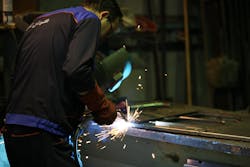Four Ways to Harness the Power of Lasers for Manufacturing Excellence
Using an industrial laser has become a viable option for achieving many manufacturing processes. It allows workers to streamline steps, improve precision and benefit from output-related gains. Decision-makers will get the best results when they consider the specific possibilities for using lasers in manufacturing. Here are some of the options.
Improve Cleaning and Texturing Methods
Many manufacturers use lasers to clean surfaces with efficiency and precision. For example, an automotive manufacturer could quickly discover how time-consuming traditional part-masking methods are. Related to this task is that techniques such as sandblasting remove contaminants but pose surface-damage risks. These are a couple of reasons manufacturers are more commonly choosing laser-based cleaning methods.
Localized laser cleaning allows manufacturers to focus on specific areas, eliminating the need for part masking. Using an industrial laser is also a way to texturize a component’s surface, such as to prepare it for thermal spraying. This approach creates repeatable patterns at the micrometer level. Manufacturers appreciate how the method supports productivity and gives predictable results, even when working with large pieces.
READ MORE: Laser-Based Welding for Joining Plastic Parts
People also use manufacturing lasers to clean parts before and after welding. This allows them to remove contaminants on the respective surfaces. Additionally, laser-cleaning methods can address the discoloration caused by oxidation, improving the weld quality of some materials.
Manufacturers can elevate their results by using artificial intelligence tools to analyze weld quality. Some automated software can automatically evaluate laser-weld seams, boosting production. They’re appealing possibilities for people already familiar with using lasers for cleaning.
Amongst the various ways workers can use lasers for cleaning, the equipment often integrates into existing assembly lines, allowing people to save space. However, people can also use handheld units, giving them more flexibility.
Decontaminate Foods Using an Industrial Laser
People working in food processing plants must deal with suspected contamination events quickly. Otherwise, consumers could become ill, leading to recalls, regulatory scrutiny, lost profits and other undesirable outcomes. Food producers must also prove they meet minimum standards for good manufacturing practices. CO2 lasers in manufacturing environments can help by destroying microbial contamination without harming the affected consumables.
When used at the right intensity, they raise the food’s temperature slightly without causing visible effects. Although some laser decontamination causes minor surface changes, manufacturers can take various actions—such as using antioxidants to reduce those effects.
READ MORE: Q&A: The Case for a Pre-engineered Laser Welding Cobot Cell
Cooking foods with CO2 lasers can reduce foodborne pathogens, preventing complications later. However, the precise nature of lasers in manufacturing means people can only treat one part of the food at a time, such as the fatty portion of a piece of bacon. Conversely, since people can tweak parameters such as the energy level and exposure time, this decontamination method gives them excellent control.
Manufacturers can also use CO2 lasers to decontaminate surfaces used for food processing, such as conveyor belts. One of the advantages of this option is it works well for removing biofilms and organic matter. The efficiency of industrial lasers is a major selling point in large food manufacturing plants where cleaning would take too long through manual methods. Relatedly, lasers offer repeatable results that typically surpass what humans can do. Since people often get tired or distracted, their outcomes are not necessarily as consistent.
Mark Products with Lasers to Support Traceability
A manufacturer’s interest in products doesn’t end when those items leave the factory. Instead, they often want to know what happens until consumers stop using those goods. Having that oversight provides many potential benefits. Careful tracing could reveal specific redesigned products will likely get processed for warranty claims within 18 months of creation. If the previous versions of those goods lasted much longer without problems, that’s a sign manufacturers should investigate possible issues with the new design.
By adding a visible detail, manufacturers make verifying that a product is a genuine article and not a counterfeit easier. It’s an excellent way for the real producer to protect their reputation. Even if a fake item comes from elsewhere, the effects can still negatively impact the company producing the real product. However, after using an industrial laser for marking purposes, a manufacturer could describe what people should look for to check authenticity.
Laser marking is also highly applicable to the manufacturing industry because it provides versatility. Someone could use an ultraviolet laser to add a mark without heat, safeguarding a component’s integrity. Lasers can even apply detailed schematic markings to a surface, providing important instructions for users. Printed circuit board manufacturers frequently choose laser marking due to its resistance to soldering.
One of the downsides of other marking methods is that post-processing methods like powder coating and heat treatments could erase the details or make them unreadable. Conversely, laser marking is exceptionally durable, providing excellent wear resistance.
Enhance Quality Control and Product Development
Manufacturers do various things to support quality control in their facilities. Their efforts could encompass employee training, equipment maintenance and stringent evaluation processes. While the human element is still important in ensuring products meet minimum standards, laser scanners can supplement people’s efforts.
One recent innovation involving ultraviolet lasers and Rayleigh scattering checks gas turbine engines. The measurements gained through this method verify turbofan components achieve the necessary thrust. Those involved with the project say it will further the development of core engine technologies and could provide in-flight measurements of non-CO2 engine emissions.
READ MORE: Laser and Seebeck Effect Key to Optical Bio-Heating, Temperature Sensing
Lasers in manufacturing also help companies ensure parts coming off production lines are within specifications. Some products on the market capture more than a million data points per second, making them much faster than what people could achieve. Humans play an essential role in verifying what the laser-measuring devices indicate and flagging any problems that arise.
Since many laser-based measuring devices work on products of various shapes, colors and materials, manufacturers can find plenty of potential uses for them. Although measuring is only one quality control aspect, it’s critical because errors in that regard could negatively affect almost everything else.
Lasers in Manufacturing Have Diverse Uses
These are only some of the many ways people can apply lasers in manufacturing and get impressive results. If you’re thinking about using an industrial laser in some of your processes, take the time to research the market’s current options and find some within your budget. Then, after investing in at least one solution, give all the respective employees adequate training so they can use the lasers safely and effectively.
A final thing to remember is the ways you use lasers may change along with the products produced, your average output and overall goals. Consider choosing at least one way to experiment with lasers in your facility. After you see whether that application makes financial sense, you’ll have the information necessary to consider scaling up your efforts.
Emily Newton is a technology and industrial journalist. She is also the editor-in-chief of Revolutionized. She has more than five years covering stories about warehousing, logistics and distribution.
About the Author

Emily Newton
Emily Newton is a technology and industrial journalist. She is also the editor in chief of Revolutionized. She has over five years covering stories about warehousing, logistics and distribution.
